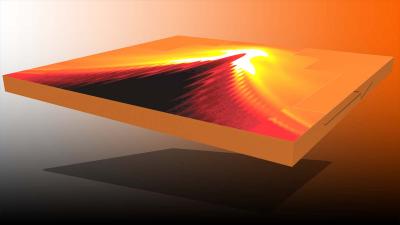Researchers at Princeton University in the US have become the first to observe a robust supercurrent at the edge of a superconductor that is very different to the supercurrent in the material’s bulk. This “topological superconductivity” could come in useful for a host of new applications, they say.
Topological materials are materials that have very different properties at the surface compared to those in their bulk thanks to special topologically protected “edge states”. Topological insulators – materials that act as insulators in their interior but conduct currents on their surface – have been a hot topic in condensed-matter research for several years, but their superconducting counterparts are less well-studied.
To find out what happens when the interior of a topological material is not an insulator but a superconductor, Nai Phuan Ong and colleagues turned their attention to molybdenum ditelluride (MoTe2). This material is a Weyl semimetal, a recently discovered class of topological material in which electrons (which are fermions, and thus have spin-1/2) behave as if they have no mass. These oddly-behaved particles were predicted in 1929 by theoretical physicist Herman Weyl as a solution to the Dirac equation (which describes the physics of normal fermions), and they travel faster and dissipate less energy than electrons in ordinary metals or semiconductors. They also show the “chiral magnetic effect” when placed in a magnetic field, which generates a current of positive and negative Weyl particles that move parallel and antiparallel to the field.
Saw-tooth pattern in critical current oscillations
The researchers began by preparing slivers of crystals of MoTe2 that were between 60 to 120 nm thick. They then cooled these crystalline samples down to below 100 millikelvin – the superconducting transition temperature of MoTe2. Next, they applied a weak magnetic field to the samples while measuring the current flow through them.
The Princeton team observed a quantity known as the critical current oscillating in a saw-tooth pattern as they increase the applied magnetic field. Both the height and frequency of these oscillations fit well with predictions of how these fluctuations arise from the quantum behaviour of electrons confined to the edges of the material, they say.
In superconducting materials, electrons overcome their mutual electrostatic repulsion to form Cooper pairs thanks to interactions between the electrons and vibrations of the material’s crystalline lattice. Once formed, these pairs behave as bosons, which have an integer spin. This means they can condense to form a “superfluid” state that behaves as a single entity, carrying electrical current through the material with no resistance at temperatures below the material’s transition temperature.
Superfluid velocity adjusts
In MoTe2 and other Weyl semimetals, this Cooper-pairing of electrons in the bulk also appears to induce a similar pairing on the edges, says Ong. The saw-tooth pattern in the critical current as the applied magnetic field increases would come from the fact that the superfluid velocity adjusts to maintain an integer number of overall twists in the phase of the superconductor’s wave function, he explains.

Sounding out Weyl fermions
While he and his colleagues say they do not yet fully understand the reason for why the edge supercurrent remains independent of bulk supercurrent, they believe it could come from the topologically protected edge states in MoTe2. To find out whether this is true, they plan to repeat their experiment on other unconventional superconductors and search for similar edge supercurrents.
Although conventional superconductors are already widely employed in areas like magnetic resonance imaging (MRI) and long-distance transmission lines, new types of superconductivity like this one could help us move beyond the limitations of familiar superconducting technologies, Ong says.
The paper, entitled “Evidence for an edge supercurrent in the Weyl superconductor MoTe2” is published in Science.
